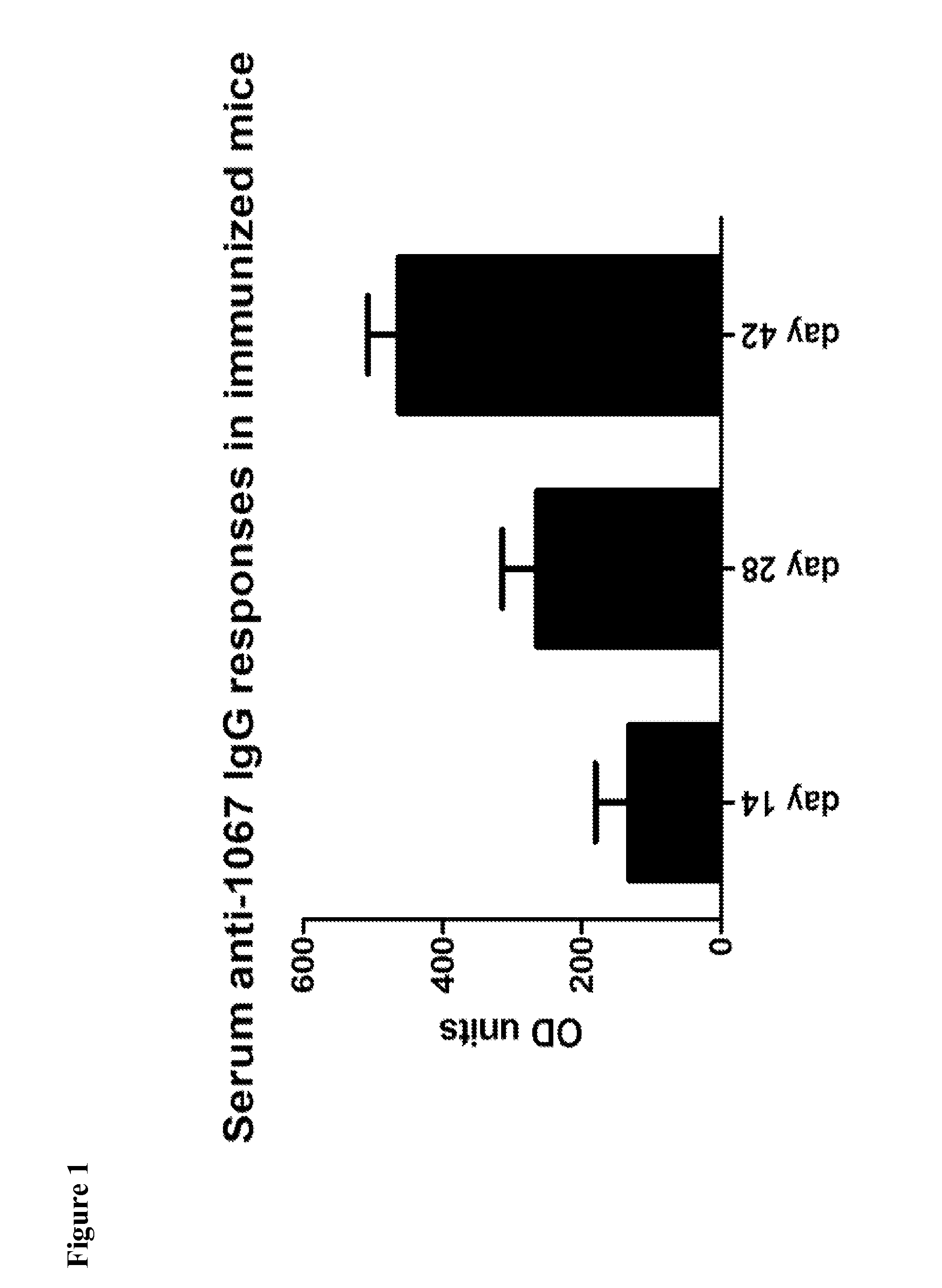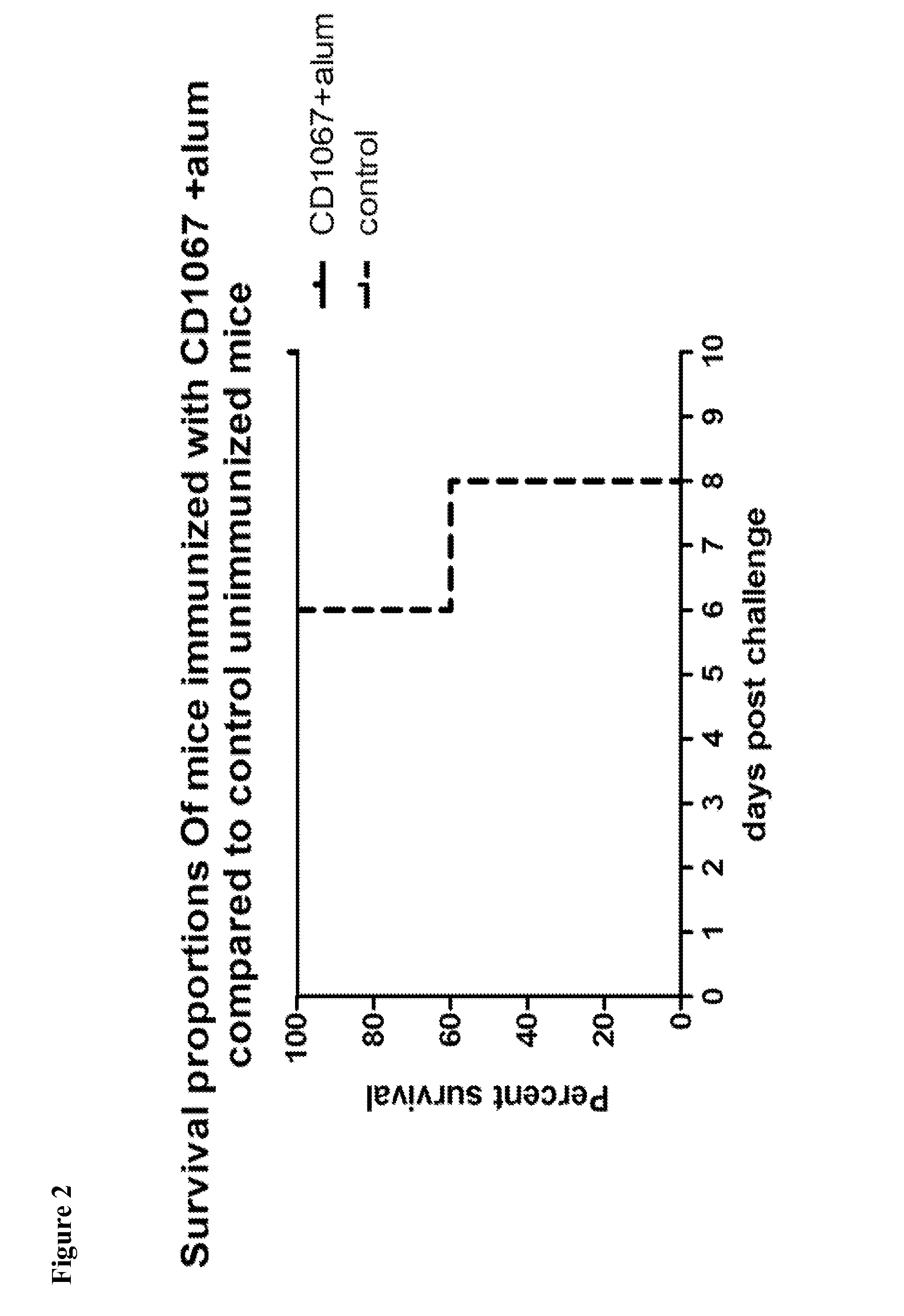Compositions and methods for prophylaxis and therapy of clostridium difficile infection
a technology of clostridium difficile and preparation method, which is applied in the field of infection-causing bacteria, can solve the problems of increased risk of cdi, unsatisfactory results, and high cost of control practices, and achieve the effect of reducing the difficulty in the subject and preventing the infection
- Summary
- Abstract
- Description
- Claims
- Application Information
AI Technical Summary
Benefits of technology
Problems solved by technology
Method used
Image
Examples
example 1
[0050]This Example provides a description of materials and methods used for making and testing polypeptides comprising CD1067 polypeptides.
[0051]Bacterial strains and media. Escherichia coli DH5 alpha was used for all subcloning steps and E. coli BL21DE3* was used for protein expression (Invitrogen, Carlsbad, Calif.). All strains were maintained at −70° C. in Luria Bertani (LB) medium containing 15% glycerol. LB medium contained ampicillin (100 μg / ml), kanamycin (50 μg / ml), X-Gal (5-bromo-4-chloro-3-indolyl-β-D-galactopyranoside) (80 μg / ml) or IPTG (isopropyl-beta-D-thiogalactopyranoside) (0.1 mM) were used (Sigma Aldrich, St. Louis, Mo.).
[0052]Genetic methods. Isolation of plasmid and bacterial chromosomal DNA, restriction enzyme digestion, agarose gel electrophoresis were performed using standard biological techniques. DNA restriction endonucleases, T4 DNA ligase, and calf intestinal alkaline phosphatase were used according to manufacturer's specifications (New England Biolabs, Be...
example 2
[0059]This Example provides a description of materials and methods used for making and testing polypeptides comprising individual and fusion CD proteins.
[0060]Bacterial strains and media. Bacteria strains and media are as described in Example 1.
[0061]Genetic methods. Isolation of plasmid and bacterial chromosomal DNA, restriction enzyme digestion, agarose gel electrophoresis were performed using standard biological techniques and as described in Example 1.
[0062]Full length protein sequences were obtained for CD1067 (SEQ ID NO:1, GenBank no. YP_001087551), BclA1 (SEQ ID NO:2; GenBank No. YP_001086801.1), SleC (SEQ ID NO:3, GenBank No. YP_001087027.1), CotA (SEQ ID NO:4, GenBank No. YP_001088114.1, Spl7 (SEQ ID NO:5, GenBank No. YP_001088081.1) FliC SEQ ID NO: 6, GenBank No. AAD46086.1, FliD (SEQ ID NO:7, GenBank No. ZP_05349430, Toxin A (GenBank No. AAA23283.1) and Toxin B (GenBank No. P18177.3)
[0063]Fusion constructs can be generated with FliC and FliD fused to CD1067, BclA1, SleC, ...
example 3
[0069]This Example demonstrates production of serum anti-CD1067 IgG responses in mice using a pharmaceutical composition comprising CD1067 and alum. Results shown in FIG. 1 were determined by kinetic ELISA and are reported as ELISA units; the geometric mean plus standard error of the mean for each cohort is shown. It is apparent that, in contrast to recently published literature, CD1067 can be used to stimulate an antibody response.
PUM
| Property | Measurement | Unit |
|---|---|---|
| pH | aaaaa | aaaaa |
| pharmaceutical composition | aaaaa | aaaaa |
| composition | aaaaa | aaaaa |
Abstract
Description
Claims
Application Information
 Login to View More
Login to View More - R&D
- Intellectual Property
- Life Sciences
- Materials
- Tech Scout
- Unparalleled Data Quality
- Higher Quality Content
- 60% Fewer Hallucinations
Browse by: Latest US Patents, China's latest patents, Technical Efficacy Thesaurus, Application Domain, Technology Topic, Popular Technical Reports.
© 2025 PatSnap. All rights reserved.Legal|Privacy policy|Modern Slavery Act Transparency Statement|Sitemap|About US| Contact US: help@patsnap.com



